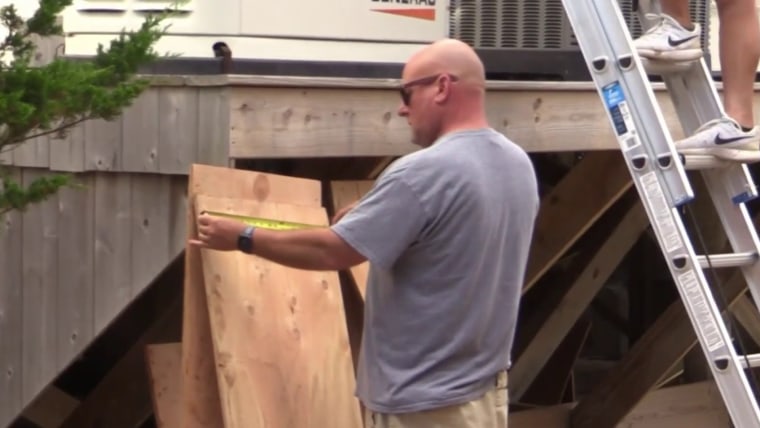Tropical Storm Henri made landfall at 12:15 p.m. on Sunday near Westerly, Rhode Island, according to the National Hurricane Center, as thousands of people already without power braced for the full effect of the storm.
Winds of 60 mph were reported at the time of landfall, according to the NHC.
Tropical storm warnings extended from coastal Connecticut and Rhode Island to the luxurious oceanfront estates of the Hamptons on the eastern end of Long Island, New York, the Associated Press reported.
Nearly 100,000 power outages were being reported for customers up the northern East Coast as of 12:30 p.m. on Sunday. The Public Service Enterprise Group, a utilities company, reported more than 1,700 of their Long Island customers had been affected by power outages.
Utility company National Grid reported more than 71,000 customers in Rhode Island and more than 3,800 in Massachusetts had been affected by power outages.
Eversource, an electric service company for Connecticut, reported nearly 20,000 customers were without power. Eversource also reported that roughly 2,500 of their eastern Massachusetts customers had been affected by power outages.
In New Jersey, at least 86 people had been rescued from flooded vehicles related to the tropical storm as of Sunday afternoon, according to the Newark Department of Public Safety.
Although the storm had been downgraded from a hurricane, many parts of New York, Connecticut, Rhode Island and southern Massachusetts were experiencing heavy rain, which could cause major flooding and wind gusts of up to 75 mph.
An 11 a.m. advisory from the National Hurricane Center said that a dangerous storm surge from Henri was expected in Long Island, Connecticut, Rhode Island and parts of southeastern Massachusetts. The advisory warned of flash flooding in those regions as well.
Experts said the storm surge is a greater danger to residents than the winds.
On Saturday, the storm caused severe weather, which interrupted a concert in New York City.
Singer Barry Manilow was in the middle of his performance at the “We Love NYC: The Homecoming Concert” in Central Park when fans were abruptly told to evacuate after lightning was seen nearby. The concert had been intended to celebrate the city’s recovery from the coronavirus.
The New York City Police Department tweeted that fans needed to evacuate but that it was “NOT an emergency.”
In other parts of New York, like Suffolk County in eastern Long Island, residents and tourists were asked to participate in a voluntary evacuation ahead of the tropical storm’s landfall.
In New York City, the heavy rain from Saturday night into Sunday morning caused some infrastructure issues, as water poured into a Queens train station. Several commuter train lines in New York City were proactively suspended ahead of the storm, including lines on Metro-North, the Long Island Railroad and Amtrak.
As of Sunday morning, a pre-landfall state of emergency had been approved for New York and Connecticut.
During a press conference on Sunday, New York Gov. Andrew Cuomo said the projected rainfall by Monday morning in New York City would be roughly two inches. He added that in the Hudson Valley region upstate, as much as five inches might fall.
Cuomo warned that the storm could slow or stall after hitting Long Island, and warned that because the ground is already saturated and the absorption ability of the ground is limited, minor flooding had already begun in parts of Long Island.
“A slow storm is a problematic storm,” Cuomo said. “When the storm slows it continues to drop rain for an extended period of time.”
On Saturday, Cuomo announced that water rescue teams were being prepared for Long Island, the Hudson Valley and Westchester County north of New York City.
He also deployed 500 National Guard troops, and state police had about 1,000 personnel on duty in areas that could be severely affected by the storm. On Sunday, Cuomo added that 500 pieces of equipment had also been deployed ahead of the storm’s landfall, but did not specify what that equipment was.
He compared Henri to 2012’s Superstorm Sandy, the effects of which are still being felt in the New York City area.
“Superstorm Sandy, which we all remember, was also a Category 1 when it hit New York state,” Cuomo said. “So, just to put it in perspective how serious this is and how dangerous it is.”
As the storm neared, officials in cities in Rhode Island and Massachusetts closed giant hurricane barriers built in the 1960s, which were constructed after storms in 1938 and 1954.
In Rhode Island, Gov. Dan McKee urged residents to stay home Sunday and into Monday morning.
“We consider this a serious matter,” McKee said at a news conference on Saturday.
Gov. Ned Lamont warned Connecticut residents they should prepare to shelter in place from Sunday afternoon through at least Monday morning as the state braced for the first possible direct hit from a hurricane in decades.
Massachusetts Gov. Charlie Baker expressed relief Saturday that the latest models suggest Henri won’t make a direct hit on the state.
But Baker and McKee at separate briefings warned that high winds and heavy rains still could lead to widespread and lengthy power outages.
The last major hurricane strike on New England was about 30 years ago. Hurricane Bob made landfall on parts of New England in 1991 and resulted in 17 deaths and $1.5 billion in damage. Long Island hasn’t had a direct hit from a hurricane since Gloria in 1985. That hurricane caused eight deaths and nearly $1 billion in damage.
A storm surge warning was in effect from Flushing, New York, to Chatham, Massachusetts, including the south and north shores of Long Island, according to the National Hurricane Center. Some parts of Long Island, Connecticut and Massachusetts were under a hurricane warning or hurricane watch.
